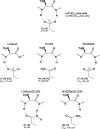A coupled array of noncovalent interactions impacts the function of the 5-HT3A serotonin receptor in an agonist-specific way
- PMID: 23077719
- PMCID: PMC3474281
- DOI: 10.1021/cn3000586
A coupled array of noncovalent interactions impacts the function of the 5-HT3A serotonin receptor in an agonist-specific way
Abstract
The serotonin type 3A (5-HT(3)A) receptor is a Cys-loop (pentameric) neurotransmitter-gated ion channel found in the central and peripheral nervous systems and implicated in numerous diseases. In previous studies with the endogenous agonist serotonin, we identified two interactions critical for receptor function: a cation-π interaction with W183 in loop B (TrpB) and a hydrogen bond to E129 in loop A. Here we employ mutant cycle analyses utilizing conventional and unnatural amino acid mutagenesis to demonstrate that a third residue, D124 of loop A, forms two functionally important hydrogen bonds to the backbone of loop B. We also show that these three interactions, the cation-π interaction, the backbone hydrogen bonds, and the E129 hydrogen bond, are tightly coupled to each other, suggesting they function as a single unit. We also identify key functional differences between serotonin and the competitive partial agonist m-chlorophenyl biguanide (mCPBG) at these residues. mCPBG displays no cation-π at TrpB and extreme sensitivity to the positioning of E129, on which it is reliant for initiation of channel gating.
Conflict of interest statement
The authors declare no competing financial interest.
Figures







References
-
- Thompson A. J.; Lester H. A.; Lummis S. C. (2010) The structural basis of function in Cys-loop receptors. Q. Rev. Biophys. 43, 449–499. - PubMed
-
- Cederholm J. M.; Schofield P. R.; Lewis T. M. (2009) Gating mechanisms in Cys-loop receptors. Eur. Biophys. J. 39, 37–49. - PubMed
-
- Beene D. L.; Brandt G. S.; Zhong W.; Zacharias N. M.; Lester H. A.; Dougherty D. A. (2002) Cation-pi interactions in ligand recognition by serotonergic (5-HT3A) and nicotinic acetylcholine receptors: The anomalous binding properties of nicotine. Biochemistry 41, 10262–10269. - PubMed
Publication types
MeSH terms
Substances
Grants and funding
LinkOut - more resources
Full Text Sources
Research Materials
Miscellaneous

